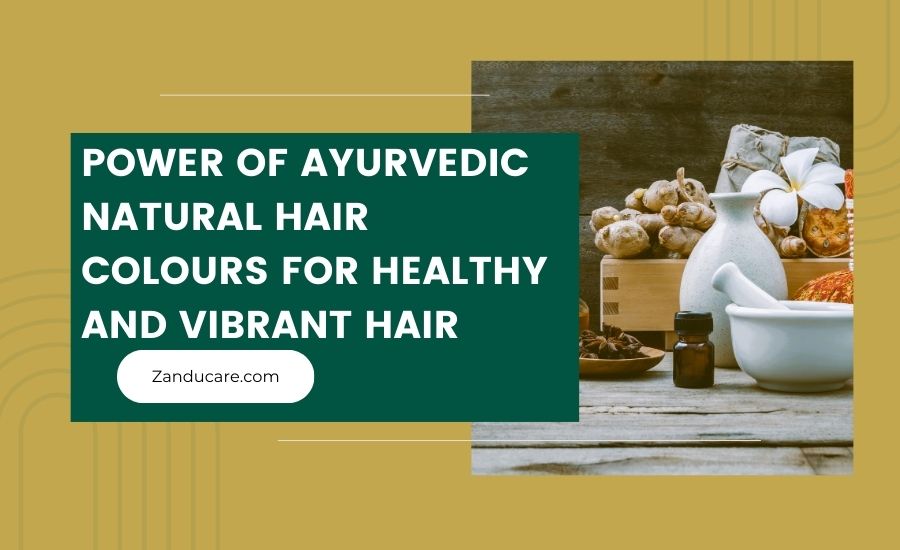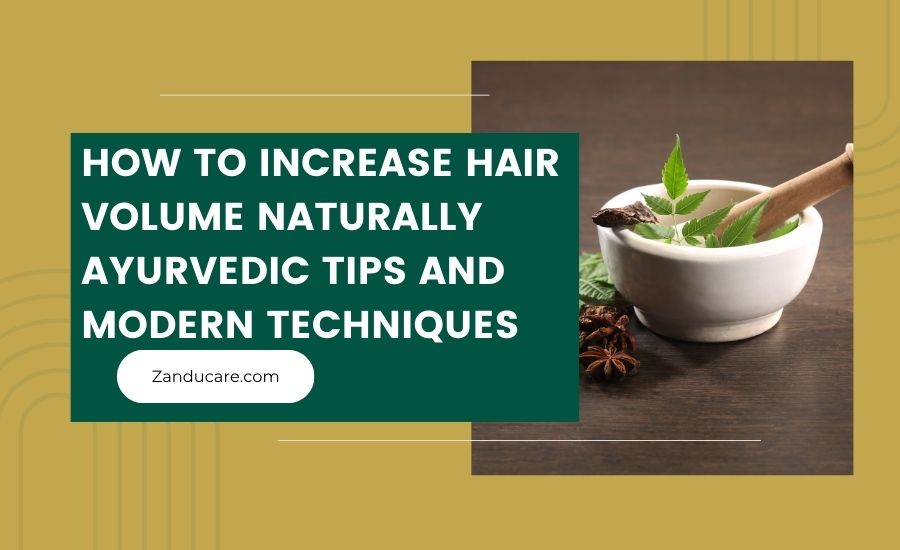
Treats Dandruff, Hair Breakage, Hair Thinning, Dull & Dry Hair | Prevents Hair Fall | Promotes Hair Growth | Improves Hair Thickness

Promotes Hair Growth | Sesame | Bhringraj | Hair Fall Control | Scientifically Proven
In recent years, whilst many are learning more about the dangers of chemical dyes,natural hair colours have grown increasingly popular. Many seek natural products to be kinder to their hair and the planet.
Ayurveda is an ancient Indian system of medicine that has nurtured a rich tradition of herbs for holistic hair care.
Ayurvedic natural hair coloursmake them look good and nourish the hair, which is the best way of getting your manes coloured with a splash and dash.
|
Did you know?
|
What are Ayurvedic Natural Hair Colours?

These natural hair colours are 100% Ayurvedic and contain plant-based ingredients used for ages in traditional Indian medicine.
Since they are made from henna, indigo, amla, and other herbs like shikakai or Bhringraj, you also receive several benefits that promote hair health with these colours. Henna has anti-fungal and anti-bacterial properties.
Ayurveda discusses these herbs not only for aesthetic purposes but also for their therapeutic features. Henna has been traditionally used as a natural dye and conditioner, while indigo complements it with darker hues.
|
Ayurvedic ingredient |
Traditional uses |
|
Indigo |
Darkening hair, enhancing shine |
|
Amla |
Strengthening hair, promoting growth |
|
Shikakai |
Cleansing, promoting hair health |
|
Bhringraj |
Hair growth, preventing greying |
Benefits of Using Ayurvedic Hair Colours

Ayurvedic hair colours have several benefits over regular chemical ones. Health-wise, these products are devoid of chemical compounds like ammonia and peroxides, which damage the hair and irritate the scalp.
On the other end of the spectrum, Ayurvedic ingredients nourish hair and scalp as they strengthen overall hair health. In environmental terms, these natural dyes are biodegradable and renewable, so they do not pollute the environment.
This is even better, as Ayurvedic hair colours offer a holistic approach to hair care. They colour your hair and condition it, nourishing the roots & strengthening your tresses while taking care of issues like dandruff and pesky white hairs.
|
Benefit |
Description |
|
Health |
No toxins. Promotes hair health. |
|
Environmental |
Eco-friendly, reduces pollution. |
|
Holistic Care |
Combines colouring with treatment. |
Key Ingredients in Ayurvedic Hair Colours
Henna (Mehndi)
Henna is a popular natural dye. It gives a reddish-orange tint while also conditioning the hair.
- Benefits: Conditions hair. Strengthens strands.
- Colour Results: Reddish tones. Depends on the hair base colour.
- Usage: Mix with water or tea and apply as a paste.
Indigo
Often used with henna, indigo gives dark tones. The tones range from brown to black.
- Benefits: Darkens hair and adds shine.
- Colour Results: Dark brown to black.
- Usage: Apply after henna for best results.
Amla

Amla is also called Indian gooseberry. It is rich in antioxidants.
- Benefits: Strengthens hair and enhances natural colour.
- Usage: Often mixed with henna or other herbs
Shikakai
Known as "fruit for hair," Shikakai is a natural cleanser.
- Benefits: Cleanses scalp. Promotes hair health.
- Usage: Used as a powder, often combined with water.
Bhringraj
Bhringraj is revered in Ayurveda for its hair growth-promoting properties.
- Benefits: Encourages hair growth and prevents greying.
- Usage: Typically mixed with Ayurvedic oils or other herbs.
Ayurveda's perspective on Hair and Hair Colouring
In Ayurveda, hair health is said to be the result of a positive integration in the body and balancing one's Vata-Pitta-Kapha. Every hair category needs diversity in care to remain healthy. The properties of Ayurvedic colours are such that they work to balance the doshas and positively affect growth for better control over common hair problems.
|
Ingredient |
Benefits |
Colour Results |
Usage |
|
Henna |
Conditions the hair and strengthens |
Reddish tones |
Paste application |
|
Indigo |
Adds shine, darkens |
Dark brown to black |
Post-henna |
|
Amla |
Strengthens, nourishes |
Enhances natural colour |
Mix with henna |
|
Shikakai |
Cleanses, promotes health |
- |
Powder form |
|
Bhringraj |
Promotes growth |
Enhances colour |
Mix with oils |
Balancing Doshas
|
Hair Type |
Characteristics |
Recommended Herbs |
|
Vata |
Thin, weak |
Bhringraj, henna |
|
Pitta |
Thin, dry |
Henna, amla |
|
Kapha |
Thick, oily |
Shikakai, neem |
Comparison of Ayurvedic Natural Hair Colours and Chemical Hair Dyes
|
Parameter |
Ayurvedic natural hair colours |
Chemical hair dyes |
|
Ingredients |
100% natural herbs (Henna, Indigo, Amla, Shikakai, etc.) |
Synthetic chemicals (Ammonia, Peroxides, PPD, etc.) |
|
Side Effects |
No known side effects, generally safe for all hair types |
Possible allergic reactions, scalp irritation, hair damage |
|
Long-term Impact |
Nourishes hair and scalp, improves hair health over time |
Chemical dyes can weaken and damage hair with prolonged use |
|
Colour Range |
Limited to natural shades (browns, blacks, reddish tones) |
A wide range of colours is available (blondes, reds, etc.) |
|
Application Process |
Requires preparation (mixing, waiting for dye to release) |
Generally easier and quicker to apply |
|
Colour Longevity |
Typically lasts 4-6 weeks, gradually fades naturally |
It can last 4-8 weeks and may require frequent touch-ups |
|
Cost |
Generally cost-effective, especially in the long run |
Often more expensive, especially salon treatments |
|
Environmental Impact |
Eco-friendly, biodegradable |
Can contribute to water pollution, non-biodegradable |
|
Maintenance |
Requires consistent care (oiling, natural shampoos) |
May require specialised shampoos and conditioners |
|
Hair Texture and Quality |
Enhances hair texture and strength |
It may cause dryness, frizz, and breakage |
|
Safety for Sensitive Scalp |
Safe for sensitive scalps, minimises irritation |
It may cause irritation and allergic reactions |
|
Customisability |
Can mix different herbs for customised results |
Limited customisability unless professionally mixed |
How to Use Ayurvedic Natural Hair Colours?
Using Ayurvedic natural hair colours involves a few simple steps that promote optimal results:
Preparation
- Mix warm water or tea with herbs (e.g., henna, indigo).
- Let it sit for some time. This will release the dye.
Application
- Apply the paste evenly on the hair.
- Cover with a shower cap and let it sit for 2-4 hours.
Rinsing
- Rinse with water; avoid shampoo for at least 48 hours to allow colour to set.
Pre-colouring hair care tips
- Oil your hair a day before application to prevent dryness.
- Use a natural shampoo to cleanse hair thoroughly.
Post-colouring hair care tips
- Avoid washing your hair immediately.
- Use mild, natural shampoos and conditioners.
- Regularly oil your hair to maintain moisture and shine.
Also, do check our related guides:
Top Ayurvedic Hair Colour products in the market
Avoid artificial hair colours. When searching for an Ayurvedic product, make sure it comprises 100% natural components. Emami Zanducare Ayurvedic hair colours have been specially formulated using natural herbs to deliver the desired shade of colour that lasts long and benefits your hair.
DIY Ayurvedic Hair Colour recipes
- Henna and indigo for brown shades: Mix henna powder with water and a splash of lemon juice. Mix the indigo powder with water and combine both pastes. Apply to hair for a rich brown colour.
- Henna and amla for reddish tones: Combine henna and amla powder with water to achieve a deep reddish-brown colour that conditions and strengthens the hair.
Tips for application
- Reddish brown: Mix henna with beetroot juice.
- Deep black: Use a higher ratio of indigo to henna.
- Golden brown: Add chamomile tea to henna.
Common Myths and Misconceptions
There are many myths about Ayurvedic hair colours:
|
Myth |
Fact |
|
Limited colour range |
Wide range of natural shades available |
|
Difficult application |
Simple with practice |
|
Ineffective grey coverage |
Effective with henna and indigo |
Conclusion
Shifting to Ayurvedic natural hair colours is a more healthy and sustainable way of colouring your hair. These natural substitutes promise that no matter what style you choose to flaunt, your dye job will come sans chemicals and fully loaded with good hair health and environmentally safe solutions!
FAQs
1. What are the benefits of using Ayurvedic hair colours?
Ayurvedic hair colours offer natural, chemical-free options that nourish the hair and scalp, providing vibrant colour and promoting overall hair health.
2. Can Ayurvedic hair colours cover grey hair effectively?
Yes, when properly mixed and applied, Ayurvedic hair colours like henna and indigo can effectively cover grey hair.
3. How long does the Ayurvedic hair colours last?
The colour typically lasts 4-6 weeks, gradually fading naturally.
4. Are there any side effects of using Ayurvedic hair colours?
Ayurvedic hair colours are generally safe and free from harsh chemicals, minimising the risk of side effects.
5. How often should I use Ayurvedic hair colours for best results?
Using these colours every 4-6 weeks helps maintain vibrant colour and hair health.
6. Can I mix Ayurvedic hair colours with regular hair dyes?
It's best to avoid mixing them, as chemical dyes can negate the benefits of Ayurvedic ingredients.
7. What is the best way to maintain the colour and health of my hair after using Ayurvedic hair colours?
Regular oiling and natural shampoos and conditioners help maintain hair colour and health.
8. Are Ayurvedic hair colours suitable for all hair types
Yes, they are suitable for all hair types and are particularly beneficial for sensitive scalps.
References
- Henna has anti-fungal and anti-bacterial properties (https://www.ncbi.nlm.nih.gov)
- Strengthens hair and enhances natural colour. (https://www.ncbi.nlm.nih.gov)
- Encourages hair growth and prevents greying. (https://www.ncbi.nlm.nih.gov)
- Chemical dyes can weaken and damage hair with prolonged use (https://www.ncbi.nlm.nih.gov)






